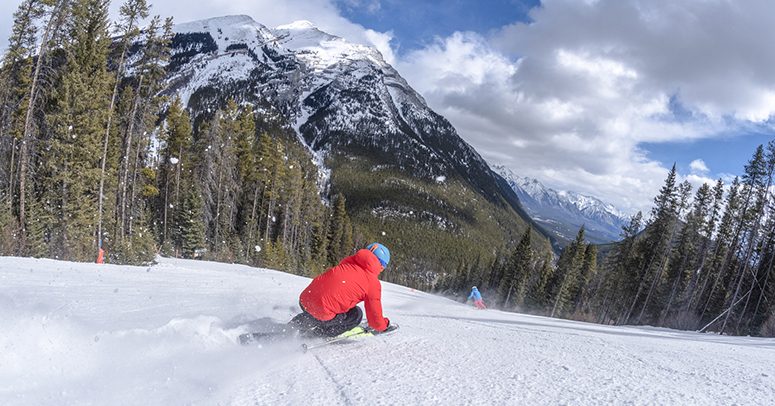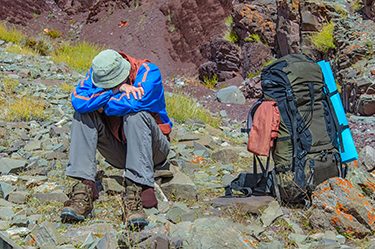Exposure-Related Injuries –
Altitude Sickness/Acute Mountain Sickness

Traveling to high altitudes exposes people to increasingly rarefied air and progressively decreasing amounts of oxygen, resulting in declining levels of oxygen in the blood and thus impaired physical and mental performance.
The response to high altitudes varies from individual to individual, but most people can operate normally at heights up to 8,000 feet (2,438 meters) above sea level. At altitudes greater than 8,000 feet, the oxygen deficit can begin to cause acute mountain sickness (AMS). At elevations higher than 10,000 feet (3,048 meters), 75 percent of people will experience at least mild AMS symptoms.
Symptoms: The onset of AMS symptoms varies according to the altitude, rate of ascent and individual susceptibility to the condition. A slow ascent will more likely allow your body to acclimate by establishing a more rapid spontaneous breathing rate to make up for the decreased oxygen in the atmosphere. Symptoms usually start 12 to 24 hours after your arrival at altitude and begin to decrease in severity by about your third day at a given elevation.
Mild AMS causes travelers to feel generally unwell. They may suffer headache, lightheadedness, fatigue, breathlessness, rapid heartbeat, nausea, difficulty sleeping or a loss of appetite. Symptoms tend to be worse at night. Mild AMS does not interfere with normal activities, and symptoms generally subside within two to four days as the body acclimates.
Severe AMS manifests itself in the form of serious conditions known as high-altitude pulmonary edema (HAPE) or high-altitude cerebral edema (HACE), which is the accumulation of excess fluid in the lungs (pulmonary) or brain (cerebral). The symptoms of severe AMS include a gray or pale complexion, a blue tinge to the skin (cyanosis), chest tightness or congestion, coughing or coughing up blood, difficulty walking, shortness of breath when at rest, withdrawal from social interaction, confusion or decreased consciousness. Severe AMS can be fatal if not treated or if the victim is not returned to a lower altitude.
Treatment: Responding promptly to signs or symptoms of AMS is essential. Immediately call emergency medical services (EMS) if you or someone else experiences any of the following symptoms:
- severe breathing problems
- altered level of alertness
- coughing up blood
If you cannot get EMS assistance, take the affected individual to a lower altitude as quickly and as safely as possible, and administer oxygen if it
is available. Keep victims warm, and be sure they stay well hydrated if
they’re conscious.
Prevention: To avoid altitude sickness, it is important to ascend slowly enough to allow time for your body to acclimate. Some people also find it beneficial to take prophylactic medication to help with the acclimatization process or to prevent some ill effects. If you plan to travel to a high-altitude location, ask your doctor or a travel clinic to evaluate your risk of altitude sickness, and obtain prophylactic medication that may prevent or alleviate AMS. If you plan to dive at a high-altitude site, make sure the medication is safe to use when diving.
AMS can affect anyone. Individuals are at higher risk if they
- live at or near sea level and travel to a high altitude
- have had AMS before
- have preexisting medical conditions
- ascend quickly to a high elevation
Do not travel to a high-altitude location without consulting your doctor if you have a heart, lung or blood disorder. You may need to travel with supplemental oxygen.
The following strategies can help prevent and/or moderate AMS:
- Do not ascend quickly above 8,000 feet.
- If you travel to high altitudes, choose a slow transportation method
or walk. - If you get there by flying, do not overexert yourself or travel higher for the first 24 hours.
- If you travel above 10,000 feet (3,048 meters), increase your altitude by no more than 1,000 feet (305 meters) per day.
- After every 3,000 feet (914 meters) of elevation gained, take a rest day.
- After daily excursions, return to a lower altitude for the night, if possible.
- Don’t go higher if you experience any AMS symptoms; wait for the symptoms to subside.
- If your symptoms increase, go to a lower elevation.
- Stay properly hydrated. Drink at least three to four quarts of fluids per day, and be sure you are urinating regularly.
- Performing light activity during the day is better than sleeping, because respiration decreases during sleep, which can exacerbate AMS symptoms.
- Avoid tobacco, alcohol and depressant drugs (such as barbiturates, tranquilizers and sleeping pills), all of which worsen AMS symptoms.
- Eat a high-carbohydrate diet while at altitude, but do not overeat.

To avoid altitude sickness, it is important to ascend slowly enough to allow time for your body to acclimate.
DAN Customer Service
Mon–Fri, 8:30 a.m. – 5 p.m. ET
+1 (919) 684-2948
+1 (800) 446-2671
Fax: +1 (919) 490-6630
24/7 Emergency Hotline
In event of a dive accident or injury, call local EMS first, then call DAN.
24/7 Emergency Hotline:
+1 (919) 684-9111
(Collect calls accepted)
DAN must arrange transportation for covered emergency medical evacuation fees to be paid.
Medical Information Line
Get answers to your nonemergency health and diving questions.
Mon–Fri, 8:30 a.m. – 5 p.m. ET
+1 (919) 684-2948, Option 4
Online: Ask A Medic
(Allow 24-48 hours for a response.)